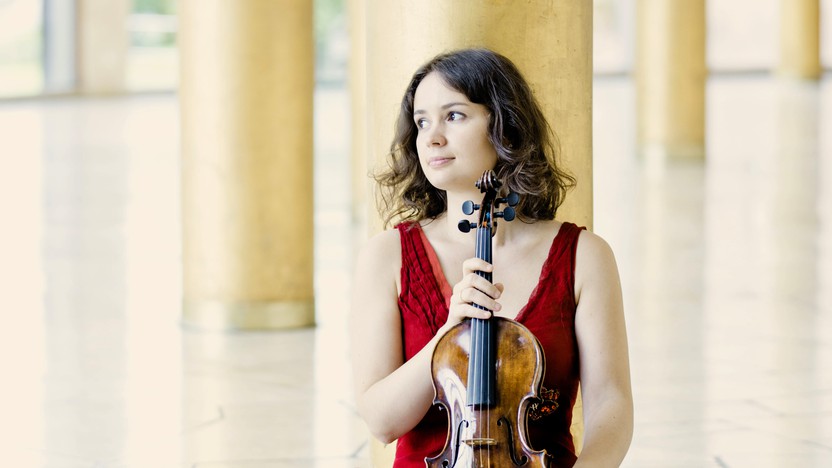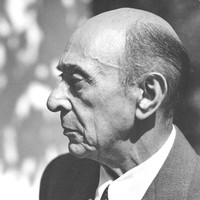Patricia Kopatchinskaja Plays Mozart’s Fourth Violin Concerto

Sponsored By
- October 28, 2017


Sponsored By


Arnold Schoenberg reached a breaking point in 1908, when his wife left him for several months to live with a young painter. Besides his personal troubles, Schoenberg was at a musical crossroads, having stretched conventional tonality to its functional limit. He took up painting, creating crude but powerful expressionist works, and he applied that same intensity of feeling to a new style of composition, first realized in the thirteenth song of the cycle The Book of the Hanging Gardens. In that song, he dispensed with a tonal center altogether and let the text and his musical instincts dictate a freely atonal language. This idiom of free atonality occupied Schoenberg for over a decade until another impasse led to his development of the 12-tone system.
Pierrot lunaire, composed in 1912, is the most famous work from Schoenberg’s “expressionist” period. He wrote it for the actress and singer Albertine Zehme, who wanted a high-art showpiece for her cabaret act. Zehme introduced Schoenberg to an 1884 collection by the Belgian poet Albert Giraud, and Schoenberg selected 21 poems, which he organized into three parts. Zehme had asked for a work for voice and piano, but Schoenberg expanded the instrumentation to include four other players: flute (doubling piccolo), clarinet (doubling bass clarinet), violin (doubling viola) and cello.
A distinguishing trait of Pierrot lunaire is the manner of vocal performance. Schoenberg wrote the vocal line in a Sprechstimme (“spoken voice”) style, in which the rhythms are precisely notated, but the pitches are only approximate and relative. He stressed in a preface to the score that the performance “must never be reminiscent of singing.” Instead, the performer’s inflections rise and fall constantly, as in natural speech.
Pierrot lunaire, or “Pierrot in the Moonlight,” borrows a stock character from the Italian Commedia dell’arte tradition, a style of improvised comedy that flourished in the seventeenth and eighteenth centuries. Pierrot was typically portrayed as a naïve fool, dressed in all white with a powdered face, and hopelessly lovesick for Columbine, who typically left him for the more dashing Harlequin.
“Moondrunk,” in which the moon is “the wine that one drinks with the eyes,” establishes the mood for the selections from Part I of Pierrot lunaire that open the program. Moons abound in the first four movements: in No. 2, Pierrot dreams of giving “moonlight’s pale blossoms” to his beloved Columbine; in No. 4, the moon is a “faded washerwoman” who “washes nighttime’s pale clothes.” The lush romanticism of Webern’s Langsamer Satz that follows directly is almost shocking in its sweetness.
In true expressionist fashion, Part II is morbid and grotesque, the text overflowing with death and blood and the colors black and red. Three selections from Part II capture this transformation of lovesickness and pale moonlight to a darker and more sinister place. The seventh song, “The Sick Moon,” a dark duet for flute and voice, features the most forlorn and intimate music of the whole song cycle, and leads into the gauzy textures of the Takemitsu.
The three final selections from Pierrot bring us home with a touch of humor and much nostalgia. No. 19 takes a musical cue from the text, in which, “with a grotesque, giant bow, Pierrot scrapes on his viola.” (The scoring actually features cello in its upper range.) No. 20, “Homeward Bound,” is an ironic barcarolle, evoking the canals of Venice. The final song imparts a sense of history and completion, with the entire instrumental array appearing.
Once the shock of hearing Pierrot lunaire wears off—and after 100 years, it is still plenty shocking—the work’s obsession with the past becomes increasingly apparent. The underlying current of nostalgia is summed up by the opening phrases of the last song: “O ancient fragrance from fabled times, ravish again my senses.”
Aaron Grad ©2017
In 1905, Anton Webern was one year into his compositional studies with Arnold Schoenberg, but even more importantly, regarding the story behind his single movement string quartet Langsamer Satz (“Slow Movement”), he was madly and deeply in love with his cousin and future bride, Wilhelmine Mörtl. In the spring of that year, the two had taken a holiday together in the forests and countryside outside of Vienna. The 21-year-old Webern wrote in his diary of the daily hikes the pair had taken: “Our love rose to infinite heights and filled the universe.” The unabashed romanticism of this declaration is reflected in the most heartfelt ways in the harmonies and lyricism of Webern’s quartet, heard here in a version for full string orchestra that allows the heightened emotions to pour forth onto a larger canvas than the original version.
Kyu-Young Kim ©2017
Toru Takemitsu was the most prominent Japanese composer of the twentieth century. Essentially self-taught, his first musical efforts adopted the French palette of Debussy and Messiaen. With encouragement from the American composer John Cage, Takemitsu began to embrace traditional Japanese sounds; he composed for instruments such as the shakuhachi and biwa (Japanese variants of the flute and lute), and even his music for Western ensembles took on a spare, Eastern aesthetic, flowing in wave-like pulses of bare gestures and gauzy harmonies.
The title of Takemitsu’s 1987 work for solo violin and string orchestra, Nostalghia, comes from a late film by the renowned Russian director Andrei Tarkovsky, who had died the previous year. (The spelling is a transliteration of the Russian word, pronounced with a hard “G,” that corresponds to “nostalgia” or “homesickness.”) Violinist Yehudi Menuhin gave the debut performance at the Edinburgh International Festival, conducted by Sir Peter Maxwell Davies.
A note printed with the score offers Takemitsu’s description of Nostalghia: “A simple and pathetic melody, introduced by the solo violin, is dominant throughout the music. Occasionally the fractionalized string orchestra creates the feeling of water and mist, which is a characteristic image in films directed by Tarkovsky, and yet the music as a whole remains wrapped in a gentle and elegiac sentiment.”
Aaron Grad ©2017

Admirers of Mozart’s serenades will find much to appreciate in his five violin concerti, which together mark the pinnacle of his music for violin. In the late eighteenth century, the serenade genre, rooted in the tradition of musical courtship (think of the lover, supported by his mandolin-strumming friends, singing beneath his beloved’s window), expanded to include more public celebrations: weddings, graduations, and the like. Per Mozart’s contemporary J.A.P. Schulz: “The title ‘serenade’ is also used for purely instrumental compositions, which, to honor or congratulate specific personages, are performed at dusk in front of their houses… The composer must strive to write simple, flowing melodies, set primarily to consonant rather than dissonant harmonies.”
The violin concerti, all completed in the year before Mozart’s twentieth birthday, might be heard as an extension of the serenades that mark his early years in Salzburg (Eine kleine Nachtmusik, et al.). They are untroubled works, recalling the serenades in both their compositional style and idyllic character. Equally so, the serenades, a number of which feature virtuosic solo violin writing, foreshadow the concerti. Mozart biographer Maynard Solomon surmises that the third, fourth, and fifth concerti specifically “are the highest examples of his serenade style after it has been detached from the serenade proper and reconstituted within a separate genre.”
The Fourth Violin Concerto is set in D major: a logical choice of key for the glorification of the violin, as it capitalizes on the instrument’s natural resonance. The opening Allegro bespeaks an irrepressible joie de vivre immediately from its opening measures. The opening theme is as uncomplicatedly ebullient as a nursery rhyme: a martial succession of unison Ds and a giddy outline of a D major chord prepare the way for “simple, flowing melodies, set primarily to consonant rather than dissonant harmonies” indeed. The Andante cantabile second movement responds to the gaiety of the Allegro with sublime beauty. Solomon describes this music as “inhabit[ing] a world of plenitude, [in which] beauty is everywhere for the taking. … [T]he beauties succeed each other with a breathtaking rapidity, their outpouring of episodic interpolations suggesting that we need not linger over any single moment of beauty, for beauty is abundant, it is to be found ‘here, too,’ and ‘there, as well.’” The concerto concludes with a playfully indecisive Rondeau: the meter vacillates between a graceful 2/4 and galloping 6/8 tempo, but the music’s prevailing lightness of spirit is assured.
Aaron Grad ©2015
Get driving directions and find nearby parking.
Find dining options close to the venue.
View seating charts to find out where you'll be seating.
Get driving directions and find nearby parking.
Find dining options close to the venue.
View seating charts to find out where you'll be seating.
